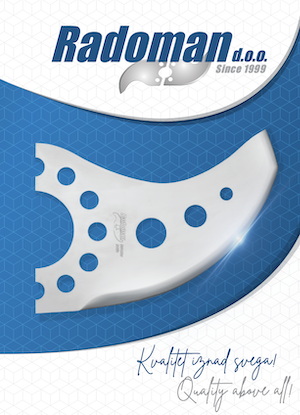Radoman produces bowl cutter knives for all kinds of machines of well-known manufacturers such as Seydelmann, Laska, Alpina, Kilia, CFS, Rex Düker, K+G Wetter, Mado and many others.
We produce bowl cutter knives in all standard sizes and shapes.
Our bowl cutter knives are better or equal to the OEM and Radoman replacement parts have proven their quality.
Cutter knives are made of high-quality special stainless steel alloy.
They are used in systems from 30 liters to 750 liters.
Check out our product range of cutter knives.
Production process
The meat industries, whether large or small, use various types of blades in their everyday production. All those delicious meat products that we eat with pleasure cannot be produced without one specific tool.
Today, we will produce a knife for cutter machine, better known as cutter knife. A simple tool yet very demanding. At the very beginning, we produce cutter knives from galvanised steel table.
In order to get the desired shape it is necessary to draw a knife first and to make a program according to which the water jet cutting machine will work after the cutting parameters are set.
For today's cutter knife we use a 7mm thick galvanized steel. Cutter knives go in sets of 6, 8 or 12 pieces and those that are produced here are used throughout the Balkans and beyond.
We enter coordinates, knife model, the pressure of the water impact and the volume of the sand impact into the program. A 4200 bar generated water pressure cuts galvanised steel table through the line of the model using red Australian sand that has so far shown the best abrasive characteristics. Cutting takes a few minutes depending on the size and shape of the knife.
After the shape of the knife is cut it is taken on the CNC machine where the future blade is made. The computer drawing with all parameters is transferred to the machine. CNC machine accurately removes the layers of material up to a certain thickness and designed shape.
The knife is now taken on the heat treatment. A secret of steel is quenching. It defines the hardness, durability of the blade and equally important toughness.
The knife is placed in a heated oven at a predetermined temperature and then cooled in the tool so as not to cause mechanical deformation.
This brings hardness and toughness to the optimum.
After the heat treatment, knives are taken on grinding. First, a surface grinding is done where the knives are placed on a machine that is programmed to remove the material to a certain thickness. The machine grinds one side of the knife and then the other side. Between these processes, the knife is thoroughly checked so that there is no error.
The thickness of the knife is 6 millimetres. After surface grinding the knives are positioned so that the machine can grind the angle of the knife. The difference from surface grinding is that it only crosses over one part of the knife and its blade, and on one side only. The set of knives is returned to the CNC milling machine, where the final steps are taken by entering the program in the same way as we did in the previous process.
Now is the time for the finest processing stage, sharpening and polishing. The quality and durability of the knife depend on sharpening which why this is a very demanding process. Polishing is the final operation in the process of cutter blade production. The same machine does both sharpening and polishing which makes it unique in this part of Europe. Every knife that comes out of the production facilities of the Radoman company from Lovcenac is identical in weight.
Finally, the Radoman logo is printed and the knife is ready for use.
Radoman company has been producing unique cutter knives for six years. The high-quality standard is something that we from the company are very proud. Customers across the countries of Balkan and all over Europe confirm this.

